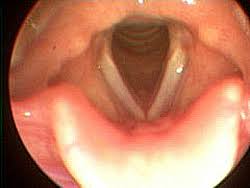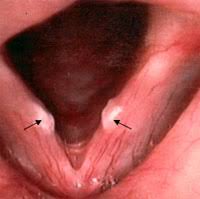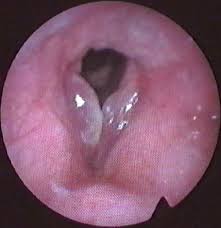Voice is produced by vibration of the vocal folds. The vocal folds are two bands of smooth muscle tissue that lie opposite each other. They are located in the larynx or voice box. The larynx is positioned between the base of the tongue and the top of the trachea (windpipe), the passageway to the lungs.
When at rest, the vocal folds are open to allow an individual to breathe. To produce voice, the brain precisely coordinates a series of events. First, the folds come together in a firm but relaxed way. Once the folds are closed, air from the lungs passes through them, causing vibration and thus making sound. The sound from this vibration then travels through the throat, nose, and mouth (resonating cavities). The size and shape of these cavities, along with the size and shape of the vocal folds, help to determine voice quality.
Variety within an individual voice is the result of lengthening or shortening, tensing or relaxing the vocal folds. Moving the cartilages, or soft, flexible bone-like tissues to which the folds are attached, makes these adjustments possible. For example, shortening and relaxing the vocal folds makes a deep voice; lengthening and tensing them produces a high-pitched voice.
What is Voice Disorders??
group of problems involving abnormal pitch, loudness, or quality of the sound produced by the larynx (voice box).
Common Voice Disorders
- Vocal nodules, commonly referred to as nodes, are callous formations on the vocal folds.
- Vocal fold paralysis, is a weakness or immobility of the vocal folds, commonly referred to as the vocal "cords."
- Reflux laryngitis, an inflammation of the larynx caused by gastric acid irritation, frequently results in decreased vocal performance.
- Vocal fold bowing, a disorder commonly seen in older adults, can result in vocal weakness.
- Vocal fold polyps are enlarged areas of the vocal folds.
- Psychogenic-based voice disorders such as conversion dysphonia/aphonia are voice problems related to emotional disorders.
- Reinke's edema is an accumulation of fluid in the vocal folds.
- Vocal fold cyst is a fluid-filled sac in the vocal folds.
- Vocal fold granuloma is an area of thickened, irregular tissue on the vocal fold caused by irritation.
- Laryngeal papilloma are growths on the larynx caused by a viral infection.
- Spasmodic dysphonia is a condition resulting in irregular voice breaks and interruptions of phonation.
- Muscle tension dysphonia is a voice disorder resulting from excessive or unequal tension while speaking or singing.

Normal Vocal cords

Vocal cords nodules

Vocal cords polyps

Vocal cords cyst

Saya adalah salah seorang pesakit Spasmodic Dysphonia di Malaysia. Sila lawati blog saya di http://9w2cde.blogspot.com/2009/06/pengalaman-saya-menghidap-penyakit.html
ReplyDeleteAsalamalikum Hana,
ReplyDeleteI am from kl and suffer from spasmodic dysphonia. I have tried botox shot but it is not helping that much when i speak.
I recently found out about Dr Mort Cooper and he says by speech therapy you can cure it by helping to speak from your face instead of your throat. Would you be able to comment on this.